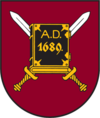Alūksne
| Alūksne | |||
|---|---|---|---|
| Town | |||

The New Castle of Alūksne
|
|||
|
|||
| Location in Latvia | |||
| Coordinates: 57°25′N 27°3′E / 57.417°N 27.050°ECoordinates: 57°25′N 27°3′E / 57.417°N 27.050°E | |||
| Country |
|
||
| District | Alūksne municipality | ||
| Town rights | 1920 | ||
| Government | |||
| • Mayor | Aivars Fomins | ||
| Area | |||
| • Total | 14.2 km2 (5.5 sq mi) | ||
| Elevation | 217 m (712 ft) | ||
| Population | |||
| • Total | 9,308 | ||
| • Density | 655/km2 (1,700/sq mi) | ||
| Time zone | EET (UTC+2) | ||
| • Summer (DST) | EEST (UTC+3) | ||
| Postal code | LV-430(1-2) | ||
| Calling code | +371 643 | ||
Alūksne (German: ![]() Marienburg ) is a town on the shores of Lake Alūksne in northeastern Latvia near the borders with Estonia and Russia. It is the seat of Alūksne municipality. Alūksne is the highest elevated Latvian city, located in East Vidzeme Upland at 217 m above sea level. The high elevation of the city affects the social and physical arrangement of the place.
Marienburg ) is a town on the shores of Lake Alūksne in northeastern Latvia near the borders with Estonia and Russia. It is the seat of Alūksne municipality. Alūksne is the highest elevated Latvian city, located in East Vidzeme Upland at 217 m above sea level. The high elevation of the city affects the social and physical arrangement of the place.
The region around Lake Alūksne was originally settled by Finnic-speaking tribes, and from the 8th-12th centuries by Latgalians. The date of settlement at the current location of the town, then known as Olysta, Alyst, and Volyst, is given in the chronicles of Pskov as 1284. The later name "Alūksne" comes from the Latgalian word olūksna, meaning a spring in the forest.
The Latgalian inhabitants of the settlement were conquered by the German crusaders of the Livonian Order in 1342 . They built a castle named Marienburg (after Mary, the mother of Jesus) on a nearby island, which served to protect trade routes from Riga to Pskov. The town which developed near the castle also became known as Marienburg.
...
Wikipedia



